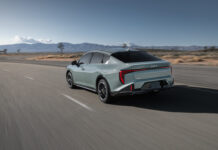When I saw my name on the list to get the Cruze Eco right after driving the one in California, I was peeved. I mean, this was going to be a boring, underpowered, striped-down Cruze built for efficiency – right? There is no way I can evaluate a lesser car like this without finding fault based on my experiences with its loaded brother – right?
Well, not exactly.
First of all, the Chevrolet Cruze Eco has the same, sprightly engine as the LT I drove in California. This was fortuitous as economy cars in the Rocky Mountains tend to bog down at high altitude; they can lose up to 30% of their horsepower in the thin air. The Cruze Eco is turbocharged, so it mitigates power loss.
Another plus: This car came with an easy to shift six-speed manual. This stick is so easy to use, I would not hesitate training my teenaged niece on this thing. It is definitely not geared for sport as the gaps between gears are massive – which helps with efficiency. Still, I had a lot of fun putting the Cruze through its paces while slapping the manual around.
Just like the Cruze LT, the Cruze Eco has the 138 horsepower 1.4 liter, four-cylinder engine. There is no change in the 148 ft-lbs torque either and THAT’S what makes this car a winner. That’s diesel-like torque in a small car.
The Hyundai Elantra, Toyota Corolla, Honda Civic and the new Ford Focus cannot match that type of power and efficiency at Rocky Mountain elevation.
Speaking of the Ford Focus and Hyundai Elantra, I think these two cars are handsome and beautifully sculpted. I love the lines of the Focus 5-door and its interior is best in class. The Elantra is modern and unique. The Chevy Cruz Eco – well – it’s kind of mellow.

The Eco has light alloy wheels and low rolling resistance rubber to optimize efficiency. Some items, like the spare tire, have been omitted to create a lighter car. A tire patch/inflator stands in for the spare. Electronically controlled shutters under the grill open and shut to increase airflow by blocking drag-inducing engine components from the air. All told, these extra steps in efficiency combine for a 42 mpg highway rating.
Even at over 5,200 feet with mixed driving – I averaged over 35 mpg in mixed driving with no detectable power loss – that’s damn good. To put that into perspective: I averaged 27 mpg in the Hyundai Elantra and 39 mpg in the Toyota Prius while driving similar routes.
“Dude, that Cruze Eco is specifically set up for high mileage!”
So what? It handles like a proper car. It’s playful in the corners despite the thin, hard tires. It’s still a Cruze and you can get a well equipped 2012 Chevrolet Cruze for about $20,000. The base Prius is about $24,000 and the Volkswagen Jetta TDI starts at about $23,000.
Not too shabby Chevy.
 Automotive media, racing, vehicle evaluation, wrecking yards, and car sales are just a part of Nathan Adlen’s vehicular past. He writes out of high octane passion! To read more reviews by Nathan Adlen or just to enjoy more of excellent writing please visit him on at his examiner.com page HERE.
Automotive media, racing, vehicle evaluation, wrecking yards, and car sales are just a part of Nathan Adlen’s vehicular past. He writes out of high octane passion! To read more reviews by Nathan Adlen or just to enjoy more of excellent writing please visit him on at his examiner.com page HERE.
Follow on twitter @TFLcar or watch latest car
review videos on YouTube.



























